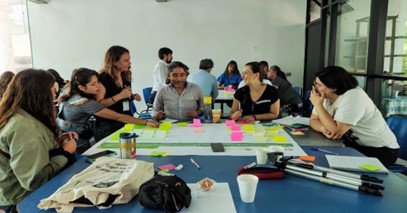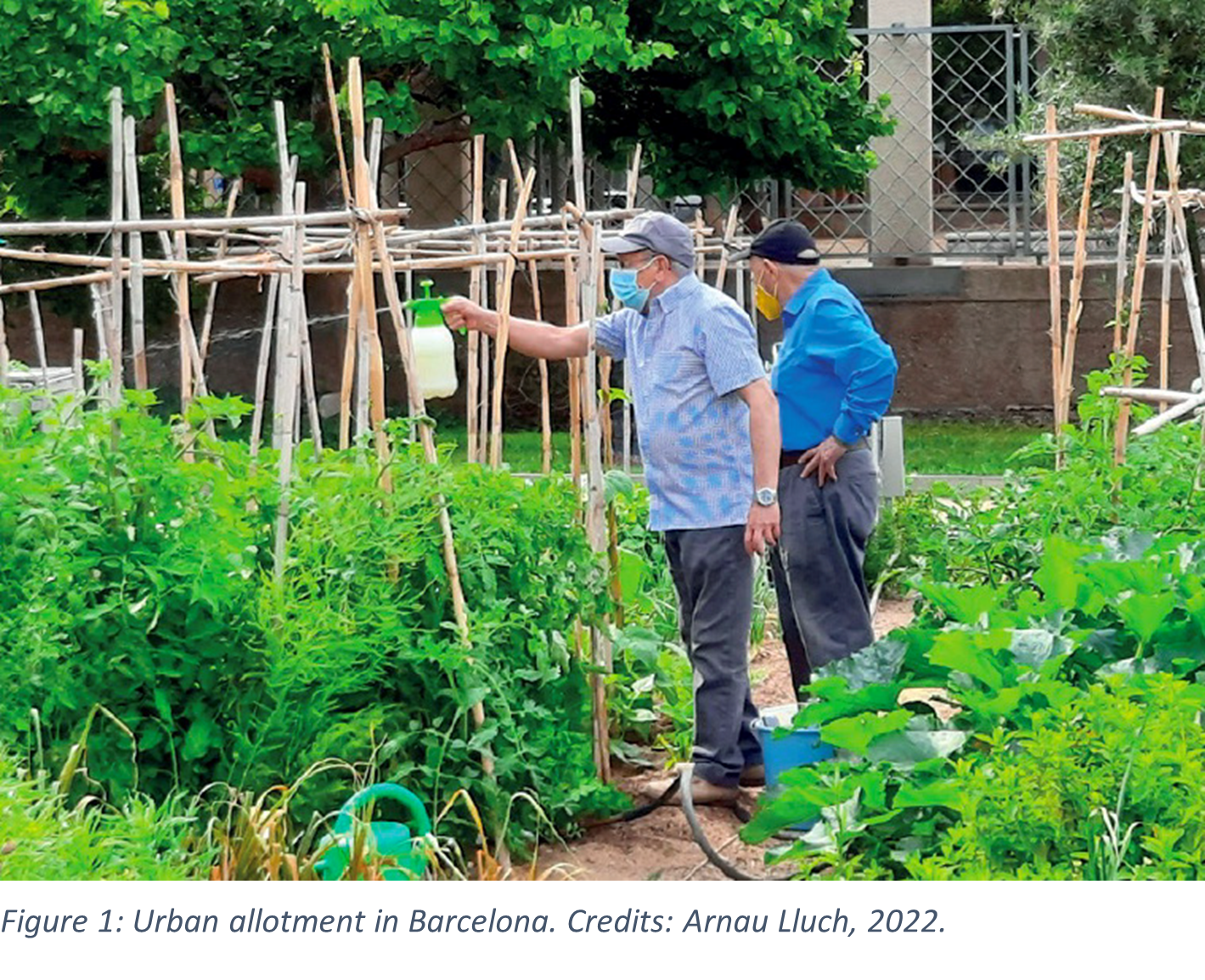
Case studies
-

CONEXUS – Restoring hydro-social systems in the Southern and Northern Borders of Bogotá
The Bogotá Life-Lab focuses on the challenges faced by urban-rural transition zones in the Southern and Northern borders of the city, whose settlements and strategic ecosystems have been negatively impacted by urban expansion processes. These territories grapple with an array of challenges related to informality and unplanned urbanisation, including land-use conflicts, socio-environmental risks resulting from local topography (e.g. settlements expanding onto mountainous and river slopes), and environmental degradation. As a result, the wellbeing and livelihood of inhabiting communities is impaired. Limited access to goods and services such as water, food, waste management, public space, transport, and health, along with direct negative impacts of peripheral ecosystems’ damage (e.g. contamination of soil and water streams, loss of agricultural or protected land, etc.) are only some of the problems at stake.
-

CONEXUS – Laboratorio BioUrbano, Santiago de Chile
Within the CONEXUS project, Santiago’s Life-Lab, Laboratorio BioUrbano, is an inter-sectoral partnership between academics, public institutions, private actors, and civil society. With the aim of co-producing urban nature-based solutions (NbS) to address the important challenges faced by the city, it proposes a series of interlinked objectives:
Improving biodiversity, water and soil health, especially in relation to the design of green space, e.g. ensuring the presence and diversity of native plant species, or water management;
More equitable distribution and access to green spaces to reverse social segregation and environmental injustices;
Mitigation of heat islands using NbS to decrease urban temperatures;
Providing opportunities for environmental education and sensibilisation, and by doing so, improving behaviour towards natural and semi-natural green spaces.
These objectives strongly reflect the multidimensional nature of NbS and are delivered through the establishment of learning communities, scientific innovation, strategic transdisciplinary alliances, and real-life experimentation which materialise five NbS pilot projects.
View on Oppla -

CONEXUS – LISGREEN: re-naturing urban spaces in Lisbon
LISGREEN embodies the following objectives:
To deliver ecological services that improve residents’ quality of life through co-produced NbS;
To generate evidence on the role of active citizenship for integrating green infrastructure into new urban models, promoting both ecological connectivity and social cohesion;
To support NbS policy upscale by introducing nature-based thinking (NBT) in policy design, implementation and evaluation supported by an inter-sectorial, multi-scale, and multi-stakeholders’ approach;
To bring NbS to the centre-stage as a public health promoter and as an agent of social justice in the framework climate change adaptation;
To leverage the dissemination of good practices and the creation of a Nature-Based Entrepreneurship (NBE) environment;
To share good practices and support replication in similar areas at the municipal and metropolitan scale (via NBT);
To interact, align, share, and learn with other cities, projects, programs, and their Life-Labs, including the transnational communities of learning created within the CONEXUS project and other projects with similar aims.
View on Oppla -

CONEXUS – Valdocco Vivibile: NbS for liveable and climate-proof neighbourhoods, Turin
The Valdocco Vivibile Life-Lab establishes a community of learning around urban NbS for ecosystem restoration, multifunctional ecosystem services, biodiversity enhancement, and social inclusion, promoting multi-stakeholder partnerships and collaborative leadership. It creates mechanisms for involving citizens, academia, and public, private, and third sectors at different governance scales through a powerful communication and dissemination strategy. A key element is the involvement of local schools and pupils in the co-creation of a public communication campaign to raise awareness of and build a shared knowledge on climate change and sustainability-related issues.
-

CONEXUS – Restoring, protecting, and maintaining thriving urban forests: three pilots in the city of São Paulo
The main objective of the São Paulo Life-Lab is to fast-forward the urban green transition by harnessing the ecosystem services of urban forests, and while doing so, tackling socio-environmental inequalities through NbS co-creation.
The Life-Lab thus aligns with the wider vision of São Paulo City to promote urban forests as global solutions to climate change and other sustainable development challenges, including with strategic policy agendas like the 'Municipal Plan for Protected Areas, Green Areas and Open Spaces', the 'Municipal Plan for the Conservation and Recovery of the Atlantic Forest', the 'Programme for Payments of Environmental Services', the 'Municipal Plan for Urban Afforestation' and the 'Municipal Climate Action Plan', put forward as instruments for carrying out the '2030 Municipal Agenda of the City of São Paulo', launched in June 2021 (WRI, n.d.).
View on Oppla -

CONEXUS – Enhancing urban biodiversity through learning communities in the city of Buenos Aires
With a network of over 25 partners across public and non-government sectors, the Life-Lab establishes multidisciplinary communities of learning to investigate and co-design NbS in order to counter a palette of harmful effects of urbanisation in the MRBA. These include, among others, air pollution, environmental degradation, and habitat loss as well as diminishing natural stormwater treatment functions, soil permeability, and water retention capacities of urban ecosystems.
Via engaging actors with direct connections to local pilots, the Buenos Aires Life-Lab aims to drive faster uptake of NbS, using real-life evidence to influence policymaking decisions towards a more resilient future. -

CONEXUS – ‘Observatori d’agricultura urbana’: Barcelona’s Urban Agriculture Observatory
In the context of the CONEXUS project, 47 of the 189 municipal allotments are being monitored by the Observatori d’Horts urbans (or ‘Urban Allotment Observatory’), a key legacy of the city’s Strategy for Urban Agriculture 2019-2030. Led by Barcelona Regional, a technical agency specialised in strategic urban planning and infrastructure, and in partnership with Barcelona City Council, the Urban Allotment Observatory analyses the ecosystem services and socio-environmental benefits of urban allotments, linking them to the city’s green infrastructure, and enhancing the evidence-base of urban agriculture’s integrated benefits for citizens and the environment.
View on Oppla -

City districts as testing grounds: integrated sustainable stormwater solutions through retrofitting in existing neighbourhoods and as part of urban transformation processes in Malmö, Sweden
The city’s green and blue areas are an important and integrated part of the city of Malmö, as reflected in the recent Master Plan. The ambitions of the Plan are to create a close, dense, green and mixed functioning city, with densification as a driver, rather than expansion into the outside highly productive farmland.
View on Oppla -

Multisectoral and multiscale articulation for urban regeneration in Medellín, Columbia, and its Metropolitan Area
The current city government, in coordination with other municipalities of the AMVA, focused its development plan (Plan de Desarrollo) priorities of implementing actions to improve the urban environment, including Nature-Based interventions from the neighbourhood to the metropolitan scale, with the support of diverse stakeholders: public institutions, private actors, civil society organisations and academic bodies.
View on Oppla -

Socio-ecological urban river restoration to mitigate flood risk, improve recreational potential and provide suitable habitats for fauna and flora: The Isar in Munich, Germany
In the second part of the 20th century, three major challenges led towards a new thinking and the implementation of river restoration as a nature-based solution for the Isar river.
View on Oppla -

Quito, Equador: Urban Agriculture as Nature Based Solution for facing Climate Change and Food Sovereignty
The project aims to tackle climate change, poverty and food provision, by supporting urban gardens in public or private land with community participation. The aims being food security and sovereignty, environmental management, employment and income improvement, social inclusion, sustainability and resilience.
View on Oppla -

Heritage zone of Xochimilco: Tlahuac and Milpa alta, Mexico City, Mexico. The importance of Nature-Based Solutions
Xochimilco is an important tourism attraction of Mexico City, and in this sense, public policies have been focused in conservation, tourism infrastructure and ecotourism. Therefore, addressing social and environmental challenges are now a priority though actions including: the dredge and cleaning of the canals, garbage collection and reforestation on channels, exotic species control, improving hydraulic infrastructure, Axolotl conservation, Chinampas rehabilitation, and productivity projects.
View on Oppla -

Green roofs in the slums of Rio de Janeiro, Brazil
Controlling and mitigating the heat island effect in Arará slum, northern Rio de Janeiro, based on the development and monitoring of green roofs, using epiphytes or lithophytes. Given the common uses of cement or metal, tiles required the development of specific techniques and materials to allow for the growth of vegetation while keeping the overall weight low for safety.
-

The Santiago Green Infrastructure Plan, Chile: towards a green infrastructure system
Developing a green infrastructure plan in Santiago as a shared territorial strategy and a means of unifying different stakeholders relevant for decision making and implementation at different spatial scales. This was achieved through a participatory approach including multiple stakeholders, workshops, and collective mapping sessions. This approach identified the principal issues, the justification of the plan, the goals, and the key spatial components.
View on Oppla -

Nature-based solutions for improving well-being in urban areas in Sheffield, United Kingdom
This case study examines in particular the interface between four sets of plans and strategies, providing important context for further examination of meso- and micro-scale interventions covered in subsequent sections. This case also touches on other formally adopted plans and strategies only in relation to the above meso- and micro- scale initiatives, in an attempt to better understand contexts.
-

Urban forests and promotion of native ecosystems in São Paulo, Brazil
São Paulo was a small village by the end of the 19th century. This village used to lie on top of the hills, surrounded by an exuberant Atlantic Rainforest and savanna, locally known as Cerrado. However, this natural landscape shifted significantly ever since, with the fast expansion of the city, mainly after the second half of the 20th century. The development of the city occurred at the expense of the natural environment, with a significant loss of biodiversity, and the addition of alien species to the city. Out of the more the 3,000 tree species from the Atlantic Rainforest, a world hotspot of biodiversity, only 577 are currently found in the city although, they must coexist and compete with an additional 185 exotic species. Most of these exotic species, introduced by projects of landscape design in public spaces and private properties. There is, however, a recent growing trend of reintroducing and restoring to some extent the ecosystems that were previously found in the area occupied by the city today.
View on Oppla
